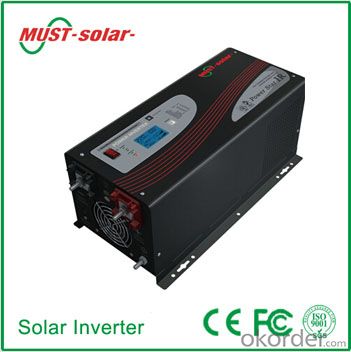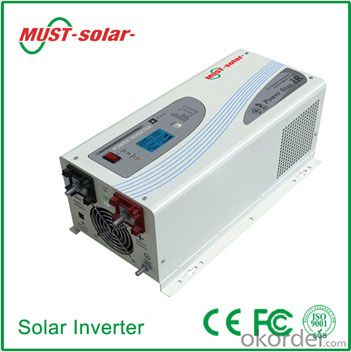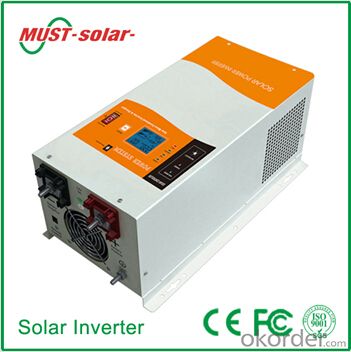Off-Grid Low Frequency PV Inverter EP3200 Series 4KW-6KW
- Loading Port:
- China main port
- Payment Terms:
- TT or LC
- Min Order Qty:
- 50 unit
- Supply Capability:
- 1000 unit/month
OKorder Service Pledge
OKorder Financial Service
You Might Also Like
1. Structure of Off-Grid Low Frequency PV Inverter Description
EP3200 series off-grid low frequency PV inverter adopt very new model copper transformer so the efficiency reach to 90% and lower
consumption (NEW !)
Pure sine wave solar hybrid inverter for solar system and home appliances . EP3200 series off-grid low frequency PV inverter developed on
the base of our very popular EP3000 series . EP3200 has achieved significant improvements on battery charging , AC transfer , bypass
etc .
By adopting DIP(Dual-in-line) switch , EP3200 series off-grid low frequency PV inverter provides more smarter options for users to
customize the performance of the device . Main for home solar system including air conditioner , refrigerator , washing machine , water
pump , fans , tv , lights etc.
2. Main Features of the Off-Grid Low Frequency PV Inverter
• High overload ability of our EP3200 charger is up to 300% rated power
• EP3200 pure sine wave inverter adopts low quiescent current, and power saver mode to reduce power consumption to 3W . It can extract
max. power from various batteries with different protections, and low voltage trip can be selected (10V/10.5V/11V).
• Uses PFC (power factor correction) for charger, which has less power consumption than conventional units.
• It has 10s delay before transfer when AC resumes, and overload protection when our APC pure sine wave inverter equips with generator.
• 10ms typical transfer time between battery and AC, which guarantees power continuity of EP3200 charger. Uses selectable input AC
voltage (185-265V or 155-255V) for different kinds of loads.
• Our EP3200 charger allows start up and through power with depleted batteries. Its powerful charge rate up to 70Amp.
• It can offer 3-step intelligent battery charging, and equipped with 6 preset battery type selector for totally flat batteries.
• LCD status display, battery/AC priority switch, RS232 communication port are available for our EP3200 pure sine wave inverter, it also
has 17 alarms/warnings for easier operation and trouble-shooting, and ability to switch the unit on/off. In addition, select/deselect power
saver mode can be used too.
3. Off-Grid Low Frequency PV Inverter Images




4. Off-Grid Low Frequency PV Inverter Specification
Rated Capacity | 4000W | 5000W | 6000W | |
Efficiency | >90% | |||
Input | ||||
Model | 120v Models | 230v Models | ||
Nominal Voltage | 100V/110V/115V/120VSelectable | 200V/220V/230V/240V Selectable | ||
Output | ||||
Rated Power | 4000W | 5000W | 6000W | |
Output Voltage | 100V/110V/115V/120V Selectable | 200V/220V/230V/240V Selectable | ||
Voltage Waveform | Pure Sine Wave | |||
Crest Factor | 3:01 | |||
Transfer Time | Transfer Time : AC To DC : 10ms (Typical) | |||
Transfer Time : DC To AC : 10ms(Typical ) | ||||
Max Bypass | 30A | |||
Overload Current | ||||
Input | ||||
Nominal Voltage | DC24V/48V | DC48V | DC48V | |
Over Current Protection | By Re-Settable Over Current Protector | |||
Output | ||||
Regulation (Nominal) | ±10% Typical Of Nominal Voltage | |||
Nominal Input Voltage | 230Vac | |||
Input Voltage Range | 185-265Vac | |||
Nominal Output Voltage | According To The Battery Type | |||
Nominal Charge Current | 30Amp-70Amp | |||
Battery Type | Lead-Acid 12Ah ~ 250Ah | |||
Typical Backup Time | No Limit | |||
Charging Method | Smart Pulse Charging With Two Charging Modes: | |||
Quick Charging When Battery Is Not Fully Charged, | ||||
Trickle Charging When Battery Is 90% Fully Charged. | ||||
Average Charging | 65A/35A | 70A/40A | 50A | |
Current | ||||
Battery Voltage options | ||||
Options 7 | Battery low trip to bypass 11v , high trip to battery 14v | |||
Options 8 | Battery low trip to bypass 10.5v , high trip to battery 13.5v | |||
Options 9 | Battery low trip to bypass 10v , high trip to battery 13v | |||
Communications & Management | ||||
Control Panel | LCD/LED Option | |||
Audible Alarm | Alarm On Battery: | |||
Low Battery & Battery Over Voltage | ||||
Alarm On Abnormal Operation: | ||||
Over Load, Short-Circuit, & Over Heat | ||||
Environment And Safe | ||||
Operating | 0℃ To 40℃ (32℉ To 104℉) | |||
Temperature | ||||
Transit/Storage | -15℃ To 60℃ | |||
Temperature | ||||
Audible Noise | 60 Dba Max at 1m | |||
Quality Control System | ISO 9001,FCC,CE | |||
Physical | ||||
Dimensions: (H×D×W) | 755*320*310mm | |||
G.W (Kg) | 37.5 | 47.5 | 47.5 | |
Packing | Export Carton For Each Unit Per Carton | |||
5. FAQ of Off-Grid Low Frequency PV Inverter
Q1. What is the difference between inverter and Off-Grid Low Frequency PV Inverter?
A1. Inverter only has AC inpput, but Off-Grid Low Frequency PV Inverter both connect to AC input and solar panel, it saves more power.
Q2. What is the difference between MPPT&PWM?
A2. MPPT has higher efficiency, it can track the max power point and won't waste energy.
Q3. What is the waranty of product?
A3. 12 months.
- Q:What is the role of a solar inverter in net metering?
- The role of a solar inverter in net metering is to convert the direct current (DC) electricity generated by the solar panels into alternating current (AC) electricity that can be used by the utility grid. It also ensures that any excess electricity generated by the solar panels is fed back into the grid, allowing the consumer to receive credits for the surplus energy produced.
- Q:What is the role of a power factor correction circuit in a solar inverter?
- The role of a power factor correction circuit in a solar inverter is to improve the power quality and efficiency of the inverter by reducing the reactive power and improving the power factor. This circuit ensures that the energy from the solar panels is effectively converted and delivered to the electrical grid, leading to a more stable and efficient operation of the solar inverter system.
- Q:What is the role of a cooling system in a solar inverter?
- The role of a cooling system in a solar inverter is to regulate and maintain the operating temperature of the inverter's internal components. This is crucial as solar inverters generate heat during the conversion of DC power from solar panels into AC power for use in homes or businesses. The cooling system helps dissipate this heat, preventing overheating and ensuring the inverter operates efficiently and reliably.
- Q:What is the maximum power output of a solar inverter?
- The maximum power output of a solar inverter depends on its capacity and specifications. It can range from a few hundred watts to several kilowatts for residential inverters, and even higher for commercial or utility-scale inverters.
- Q:Can a solar inverter be connected to a computer or smartphone?
- Yes, a solar inverter can be connected to a computer or smartphone. Many modern solar inverters come with built-in Wi-Fi or Bluetooth capabilities that allow them to connect to these devices. Through dedicated mobile apps or software, users can monitor their solar system's performance, adjust settings, and receive real-time data and alerts directly on their computer or smartphone.
- Q:How does a solar inverter affect the overall system reliability in harsh environments?
- A solar inverter plays a crucial role in enhancing the overall system reliability in harsh environments. It acts as the interface between the solar panels and the electrical grid, converting the direct current (DC) generated by the panels into alternating current (AC) that can be used in our homes or businesses. In harsh environments with extreme temperatures, high humidity, or dust and debris, the inverter's design and components must be specifically engineered to withstand these conditions. Robust protection against environmental factors ensures the inverter's longevity and uninterrupted operation. Additionally, advanced features such as temperature regulation, fault detection, and rapid shutdown mechanisms further enhance system reliability, ensuring consistent power generation and minimal downtime.
- Q:Can a solar inverter be used in a multi-string configuration?
- Yes, a solar inverter can be used in a multi-string configuration. A multi-string configuration refers to connecting multiple strings of solar panels to a single inverter. This setup allows for better utilization of the inverter's capacity and can accommodate larger solar installations.
- Q:What is the role of a display interface in a solar inverter?
- The role of a display interface in a solar inverter is to provide real-time information and control options to the user. It allows the user to monitor the performance of the solar inverter, such as its power output, voltage levels, and error status. The display interface also enables the user to adjust settings, configure parameters, and troubleshoot any issues that may arise. Overall, it serves as a user-friendly tool for managing and optimizing the operation of the solar inverter system.
- Q:How does a solar inverter handle voltage dips and swells?
- A solar inverter handles voltage dips and swells by utilizing various protective mechanisms. When there is a voltage dip, the inverter typically has a built-in low voltage ride-through capability, which allows it to continue operating even if the grid voltage temporarily drops. The inverter adjusts its power output to match the reduced voltage, ensuring a stable and reliable energy supply. In case of voltage swells, the solar inverter employs voltage regulation techniques to prevent excessive voltage from harming the system. It monitors the grid voltage and adjusts its own output accordingly, ensuring that the generated solar power is safely integrated with the grid. This regulation mechanism helps protect both the inverter and other connected devices from potential damage caused by high voltage levels. Overall, the solar inverter's ability to handle voltage dips and swells is crucial for maintaining the stability and efficiency of a solar power system, enabling it to seamlessly adapt to varying grid conditions and safeguarding the equipment involved.
- Q:Can a solar inverter be used in regions with high altitude conditions?
- Yes, a solar inverter can be used in regions with high altitude conditions. However, it is important to consider certain factors such as temperature, air density, and potential voltage fluctuations that can affect the performance of the solar inverter at high altitudes. Specialized inverters or adjustments may be required to ensure optimal functioning in such conditions.
1. Manufacturer Overview |
|
|---|---|
| Location | |
| Year Established | |
| Annual Output Value | |
| Main Markets | |
| Company Certifications | |
2. Manufacturer Certificates |
|
|---|---|
| a) Certification Name | |
| Range | |
| Reference | |
| Validity Period | |
3. Manufacturer Capability |
|
|---|---|
| a)Trade Capacity | |
| Nearest Port | |
| Export Percentage | |
| No.of Employees in Trade Department | |
| Language Spoken: | |
| b)Factory Information | |
| Factory Size: | |
| No. of Production Lines | |
| Contract Manufacturing | |
| Product Price Range | |
Send your message to us
Off-Grid Low Frequency PV Inverter EP3200 Series 4KW-6KW
- Loading Port:
- China main port
- Payment Terms:
- TT or LC
- Min Order Qty:
- 50 unit
- Supply Capability:
- 1000 unit/month
OKorder Service Pledge
OKorder Financial Service
Similar products
New products
Hot products
Hot Searches
Related keywords
































